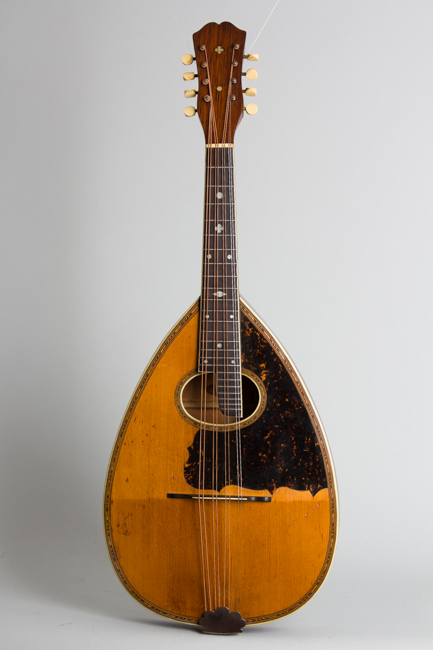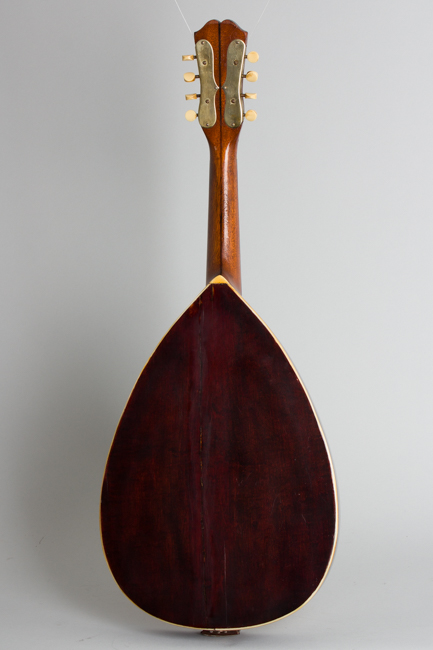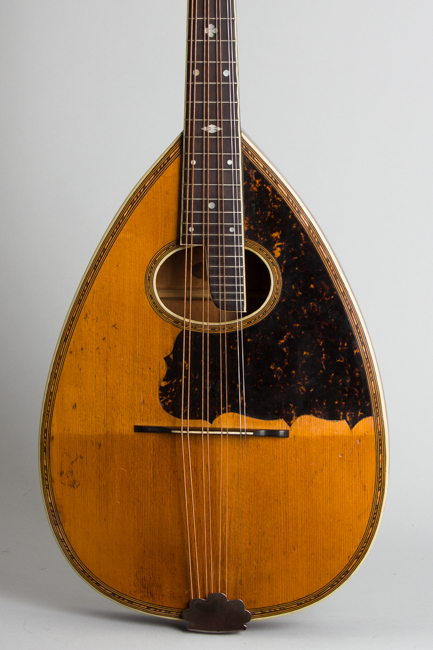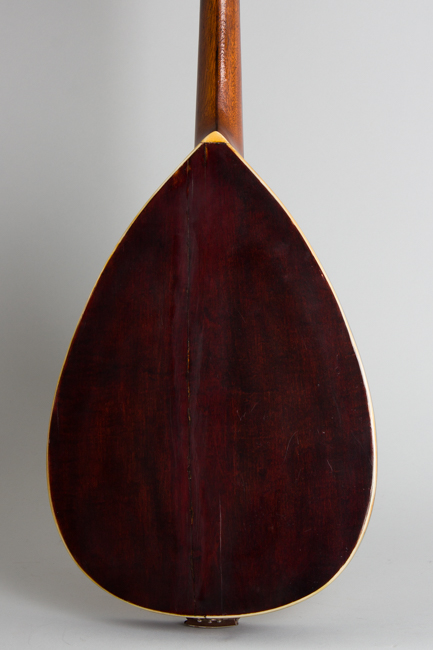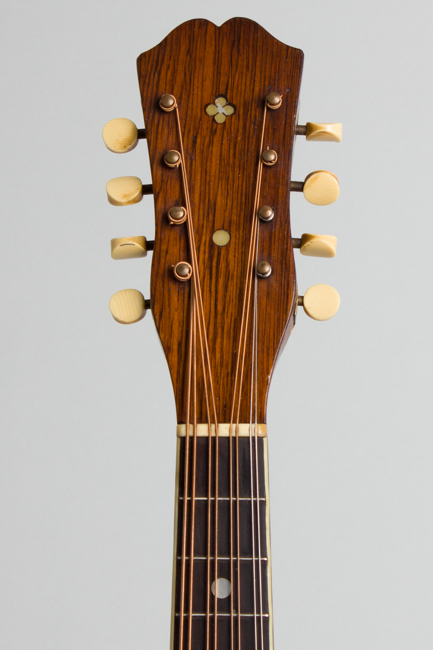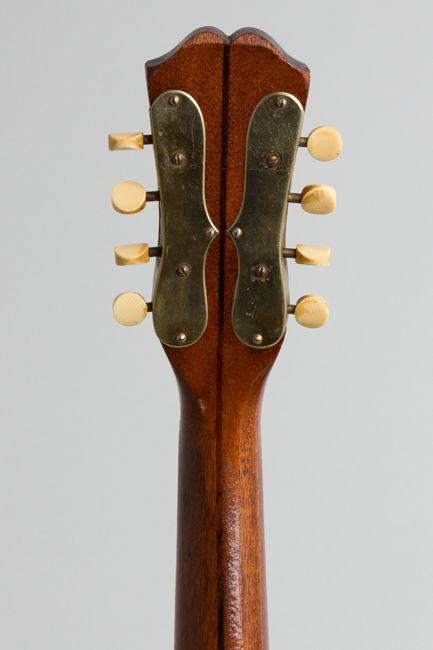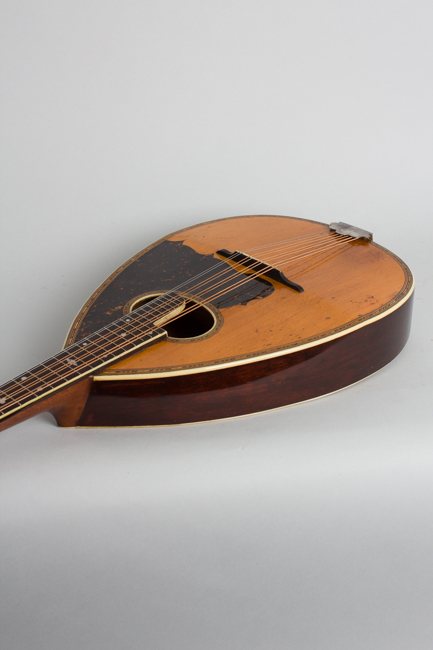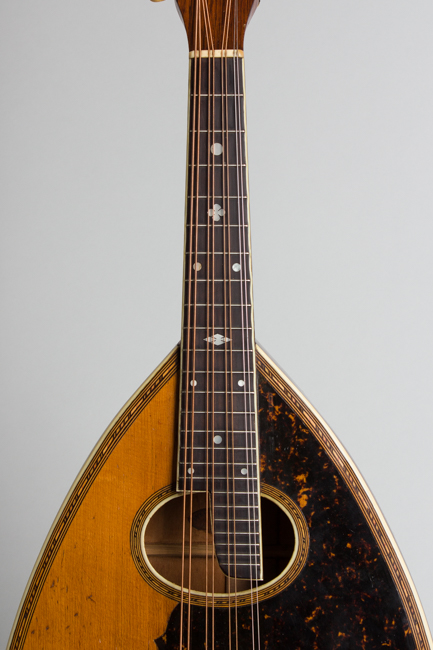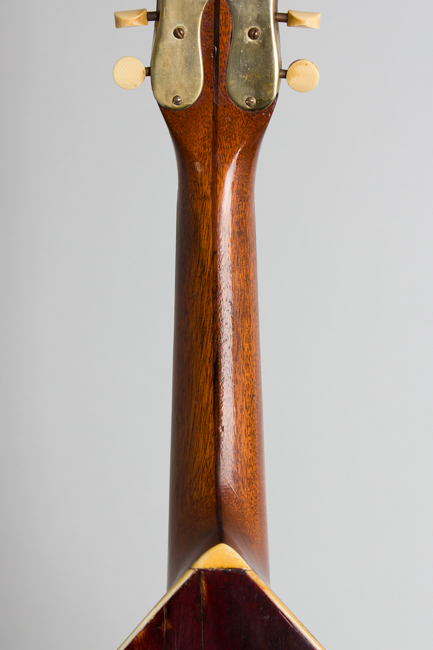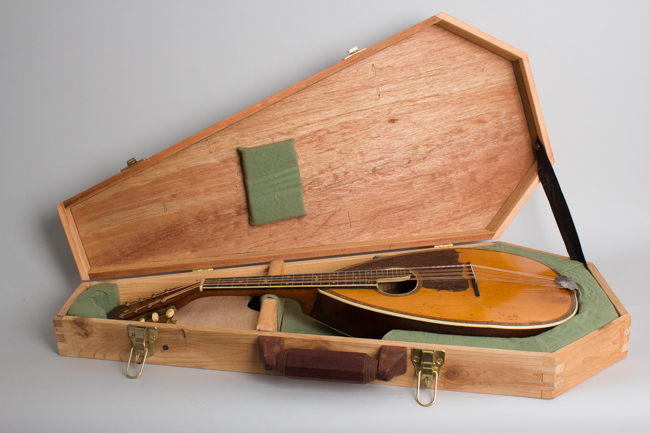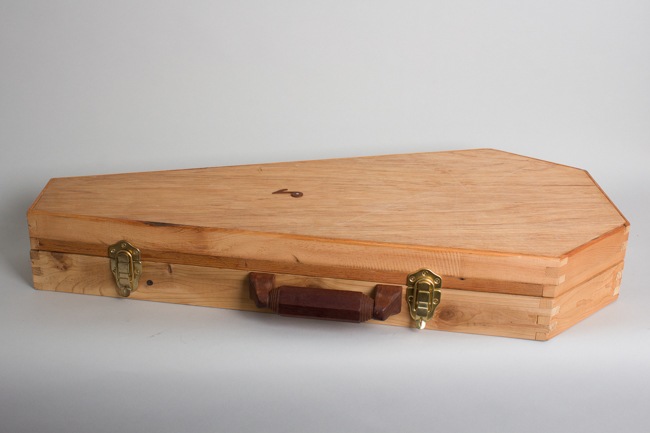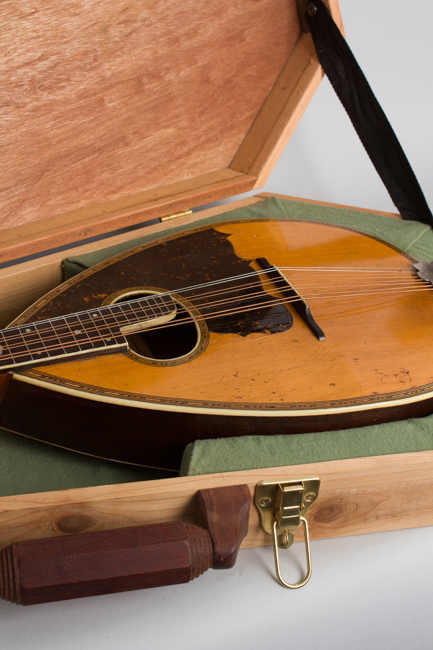Wm. Stahl Flat back, bent top Mandola, made by Larson Brothers , c. 1920
This item has been sold.
Item # 10401
Prices subject to change without notice.
Wm. Stahl Model Flat back, bent top Mandola, made by Larson Brothers, c. 1920, made in Chicago, natural top, faux rosewood back and sides finish, maple back and sides, spruce top; laminated mahogany neck with ebony fingerboard, hand made wooden case.
In the early 1900s the Larson Brothers of Chicago were becoming known in the fretted industry for their design and workmanship excellence. Soon enough they were contracted by several different teacher/publisher/dealers to supply high grade steel-string instruments to be sold under several unrelated brands. 1910's Fretted publications sometimes carried side-by-side ads featuring Larson-made instruments sold from different cities under unrelated names!
One of them was William C. Stahl of Milwaukee, a virtuoso mandolin player turned teacher and music publisher. Around 1906 the Larsons began supplying instruments to Stahl, who claimed to be the maker. He was one of the brother's biggest accounts; their wares made up the bulk of his line as advertised starting around 1907. Stahl scoffed at "machine made" instruments, insisting his are "hand made...reasonable in price and perfect as human hands can make them". He claims they were built under his "personal supervision", quite a trick as the Larsons were building them in Chicago while Stahl's offices were in Milwaukee!
Stahl was of the bowl-back era and harbored particular disdain for Gibson, filling ads with not so subtle digs at them. In 1907 he wrote: "The Stahl mandolin is the regulation shaped instrument and not a freak or musical novelty as advertised by some makers". When Larson-made Stahls were genuinely among the best non-Gibson mandolin family instruments available. He claimed they were the "Loudest and sweetest toned musical instruments in the world".
By late 1912 Stahl's ads picture flat-back style mandolins, called "English Model". "We have flat back models...for those who want them" he practically sighs. The Martin A-E series, Weymann Mandolute and the Lyon & Healy "Leland Mandos" (also made by the Larsons) appeared around the same time, signaling the imminent demise of the bowl-back mandolin. Playing on his name's "steel" translation, he continued "The music of the future won't be the caterwauling of Gut. It will be the virile pulsing of the plucked steel string". He was right there at least!
Today William Stahl is primarily remembered for instruments the Larsons supplied him well up into the 1930's, especially the mandolin, mandola, octave mandolin, mando-cello and even mando-bass made to the same harmonized pattern. While the design is relatively conventional the Larson's construction expertise shines. This lovely mandola has seen a lot of re-working but remains typical, with a hot-stamp burned into the inside back stating "Wm. C. Stahl, Maker, Milwaukee". The serial number is lost but the instrument likely dates to the mid/late 'teens.
The natural-finished top is spruce, with a large inlaid celluloid pickguard. The maple body sports a faux-rosewood finish, of which August Larson was a master. The neck is mahogany with a laminated ebony center strip, topped with the Larson's typical thick ebony fingerboard. This is inlaid with pearl shapes and dots, while the body is trimmed with colored wood marquetry. Both are bound in ivoroid. The tuners, clamshell tailpiece and bone-saddle ebony bridge are conventional period mandolin fittings.
Stahl mandolas like this one are superlative instruments, and quite rare. The ladder-braced spruce top is more responsive than the heavy carved Gibson; especially when played solo they have a totally distinctive sound. Only rarity and the rather limited interest today in such specialized instruments prevents them being better appreciated 100+ years on. Stahl advertised that his wares were the best that could be had, claiming "no instruments can be made any better". In engaging the Larsons to build them he fulfilled that promise!
Overall length is 28 1/2 in. (72.4 cm.), 10 15/16 in. (27.8 cm.) wide at lower bout, and 2 1/4 in. (5.7 cm.) in depth at side, taken at the end block. Scale length is 16 in. (406 mm.). Width of nut is 1 5/16 in. (33 mm.).
This instrument sounds and plays very well, but has seen some fairly extensive re-working likely decades ago. It appears that the three main top braces replaced, on the original style but somewhat deeper than the originals. The back/side kerfing has been redone, not surprising as the back would have been removed to allow for this work.
A major crack running the full length of the back has been repaired with an unusually large single backstrip/cleat running the length of the instrument. This is solid but somewhat cosmetically challenged, although it was neatly cut away to preserve the original Stahl hot stamp. A couple of smaller cracks to the back are visible as well, with one small split to the top at a corner of the inlaid pickguard. The neck appears to have been reset which was well done, and not an easy job on this design. The strip of binding on the fingerboard extension over the soundhole is an over-deep replacement.
The finish is a mix of eras; The faux-rosewood back and sides are overfinished, retaining some original staining but with a later overcoat, heavier on the back. Most of the neck was refinished, leaving the headstock original, possible polished out on the face. The top finish remains original, also possibly polished out but still showing the typical Larson micro-checking. There are some dings, dents and scrapes overall with the heaviest on the top.
The tuners and bridge appear original, as does the tailpiece; the tailpiece cover is the correct original style anyway. Written inside the body in pencil or ball point pen it reads "REPAIR BY HARPP(?) SHOPPE JAN 71" so the major structural work is now over 50 years old and holding well. Oddly enough the thin frets appear original and in decent condition with some minor wear in the standard lower position spots. Despite a rather epic repair history this is a fine playing and sounding instrument, still quite unique both in feel and tome a century or more on. It is housed in a handmade coffin style case, a bit amateur looking but quite functional. Overall Very Good + Condition.
In the early 1900s the Larson Brothers of Chicago were becoming known in the fretted industry for their design and workmanship excellence. Soon enough they were contracted by several different teacher/publisher/dealers to supply high grade steel-string instruments to be sold under several unrelated brands. 1910's Fretted publications sometimes carried side-by-side ads featuring Larson-made instruments sold from different cities under unrelated names!
One of them was William C. Stahl of Milwaukee, a virtuoso mandolin player turned teacher and music publisher. Around 1906 the Larsons began supplying instruments to Stahl, who claimed to be the maker. He was one of the brother's biggest accounts; their wares made up the bulk of his line as advertised starting around 1907. Stahl scoffed at "machine made" instruments, insisting his are "hand made...reasonable in price and perfect as human hands can make them". He claims they were built under his "personal supervision", quite a trick as the Larsons were building them in Chicago while Stahl's offices were in Milwaukee!
Stahl was of the bowl-back era and harbored particular disdain for Gibson, filling ads with not so subtle digs at them. In 1907 he wrote: "The Stahl mandolin is the regulation shaped instrument and not a freak or musical novelty as advertised by some makers". When Larson-made Stahls were genuinely among the best non-Gibson mandolin family instruments available. He claimed they were the "Loudest and sweetest toned musical instruments in the world".
By late 1912 Stahl's ads picture flat-back style mandolins, called "English Model". "We have flat back models...for those who want them" he practically sighs. The Martin A-E series, Weymann Mandolute and the Lyon & Healy "Leland Mandos" (also made by the Larsons) appeared around the same time, signaling the imminent demise of the bowl-back mandolin. Playing on his name's "steel" translation, he continued "The music of the future won't be the caterwauling of Gut. It will be the virile pulsing of the plucked steel string". He was right there at least!
Today William Stahl is primarily remembered for instruments the Larsons supplied him well up into the 1930's, especially the mandolin, mandola, octave mandolin, mando-cello and even mando-bass made to the same harmonized pattern. While the design is relatively conventional the Larson's construction expertise shines. This lovely mandola has seen a lot of re-working but remains typical, with a hot-stamp burned into the inside back stating "Wm. C. Stahl, Maker, Milwaukee". The serial number is lost but the instrument likely dates to the mid/late 'teens.
The natural-finished top is spruce, with a large inlaid celluloid pickguard. The maple body sports a faux-rosewood finish, of which August Larson was a master. The neck is mahogany with a laminated ebony center strip, topped with the Larson's typical thick ebony fingerboard. This is inlaid with pearl shapes and dots, while the body is trimmed with colored wood marquetry. Both are bound in ivoroid. The tuners, clamshell tailpiece and bone-saddle ebony bridge are conventional period mandolin fittings.
Stahl mandolas like this one are superlative instruments, and quite rare. The ladder-braced spruce top is more responsive than the heavy carved Gibson; especially when played solo they have a totally distinctive sound. Only rarity and the rather limited interest today in such specialized instruments prevents them being better appreciated 100+ years on. Stahl advertised that his wares were the best that could be had, claiming "no instruments can be made any better". In engaging the Larsons to build them he fulfilled that promise!
Overall length is 28 1/2 in. (72.4 cm.), 10 15/16 in. (27.8 cm.) wide at lower bout, and 2 1/4 in. (5.7 cm.) in depth at side, taken at the end block. Scale length is 16 in. (406 mm.). Width of nut is 1 5/16 in. (33 mm.).
This instrument sounds and plays very well, but has seen some fairly extensive re-working likely decades ago. It appears that the three main top braces replaced, on the original style but somewhat deeper than the originals. The back/side kerfing has been redone, not surprising as the back would have been removed to allow for this work.
A major crack running the full length of the back has been repaired with an unusually large single backstrip/cleat running the length of the instrument. This is solid but somewhat cosmetically challenged, although it was neatly cut away to preserve the original Stahl hot stamp. A couple of smaller cracks to the back are visible as well, with one small split to the top at a corner of the inlaid pickguard. The neck appears to have been reset which was well done, and not an easy job on this design. The strip of binding on the fingerboard extension over the soundhole is an over-deep replacement.
The finish is a mix of eras; The faux-rosewood back and sides are overfinished, retaining some original staining but with a later overcoat, heavier on the back. Most of the neck was refinished, leaving the headstock original, possible polished out on the face. The top finish remains original, also possibly polished out but still showing the typical Larson micro-checking. There are some dings, dents and scrapes overall with the heaviest on the top.
The tuners and bridge appear original, as does the tailpiece; the tailpiece cover is the correct original style anyway. Written inside the body in pencil or ball point pen it reads "REPAIR BY HARPP(?) SHOPPE JAN 71" so the major structural work is now over 50 years old and holding well. Oddly enough the thin frets appear original and in decent condition with some minor wear in the standard lower position spots. Despite a rather epic repair history this is a fine playing and sounding instrument, still quite unique both in feel and tome a century or more on. It is housed in a handmade coffin style case, a bit amateur looking but quite functional. Overall Very Good + Condition.
